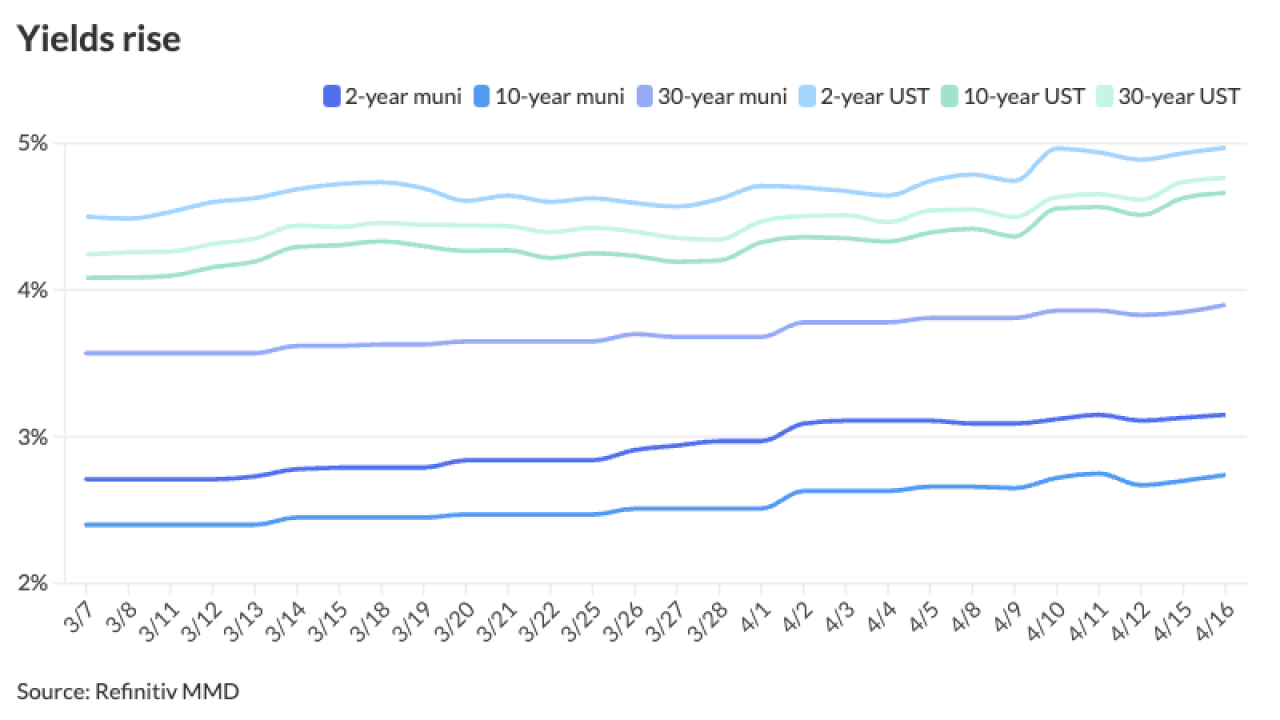Municipal bonds held steady across the yield curve Thursday, capping a slow and steady week that saw tax-exempt yields rise about one basis point throughout.
The tone contrasted with the Treasury market, where yields dropped as much as seven basis points Thursday and nine basis points over the past five trading sessions.
“We have pushed high-grade bonds as far as people are willing to step out and take them,” a tax-exempt trader in New York said. “They’ll take them at these yields, but not any lower.”
But while buyers are hesitant to probe the level of high-grade bonds, certain lower-graded paper improved a basis point as there’s a feeling that overall interest rates are not turning around, and credit risk among lower-rated bonds has diminished, so people are willing to step down the credit scale a bit.
“There’s been a slight improvement in lesser-rated bonds and I think it’s good for the market — it establishes some base underneath the high-grades,” he said.
The Municipal Market Data triple-A scale showed the two-year yield remain at 0.44% all week, while the 10-year yield rose a single basis point to 2.65%, and the 30-year yield fell a single basis point to 4.30%.
“It certainly was curious how reluctant the tax-exempt sector was to follow the Treasury rally today,” Randy Smolik wrote in MMD’s closing commentary. He described midday trading in the secondary market as “dead.”
“Not much is getting done in the municipal market as the holiday weekend fast approaches,” Alan Schankel, managing director at Janney Capital Markets, wrote in a daily note.
Schankel noted that the upcoming calendar appears light even with the addition of a $510.6 million issue from the New York Environmental Facilities Corp. — the largest on next week’s calendar.
Issuance is anticipated to be $2.6 billion in the holiday-shortened week, according to Thomson Reuters, marking the third week-to-week decline. This week’s calendar was roughly $3.4 billion.
The New York trader said the next thing to shake muni prices might be the May employment report scheduled for release on June 3.
Other traders said the market was quiet as investors were comfortable holding current positions heading into the three-day Memorial Day weekend.
Despite the underperformance this week, a trader in San Francisco said there is more demand out there than there is new paper, so prices should hold at current levels going into next week and beyond.
“That’s the trend going into June — a lot of cash is flowing around,” he said.
The steady tone didn’t stop a number of yield indexes from reaching fresh 2011 lows.
The Bond Buyer’s 20-bond general obligation index of 20-year yields declined two basis points this week to 4.53%, a 28-week low. The 11-bond GO index of higher-grade 20-year GO yields dropped two basis points this week to 4.27%, also a 28-week low.
The revenue bond index, which measures 30-year revenue bond yields, declined two basis points this week to 5.38%, a 21-week low.
The Bond Buyer’s one-year note index fell five basis points to 0.38% — an all-time low for the index, which began July 1989. The previous record low was 0.39%, on March 10, 2010.
The average weekly yield to maturity of The Bond Buyer municipal bond index, which is based on 40 long-term bond prices, declined one basis point to 5.37%, a 25-week low.
“The market is firm but there’s just not a lot of trading,” the San Francisco trader said. “Traders are here but customers just aren’t looking for stuff, both on the institutional and retail side.”
Muni underperformance caused the 10-year muni-Treasury ratio to tick up to 86.6% Thursday — its highest since May 9 — up from 83.1% last Friday. Its long-term average is just above 83%.
Muni commentators continue to be optimistic that current valuations are appropriate for the summer.
“There seems to be a concern shift away from credit default concerns and towards a potential concern for the loss of tax-exemption,” said Peter Delahunt, trading manager for munis at Raymond James in New York. “So we could see ratios go through the mean and have a shift there.”
Delahunt said falling Treasury rates coupled with a lack of tax-exempt supply were the main reasons behind the recent rally in municipals. And plenty of reasons support these levels with muni mutual outflows coming to an end, the market entering the June-July reinvestment period, and little growth in supply on the medium-term horizon.
The Investment Company Institute, a trade group for the mutual fund industry, reported a net inflow of $63 million into muni funds for the week ending May 18. That marks the second gain in a row, albeit another very small one, following six months of hefty net outflows that totaled $45.3 billion.
“So technically speaking we’re in good shape,” Delahunt said. “And fundamentally, we’ve had five straight quarters of increasing state revenues, so we’re starting to get a little better there.”
But he said retail buying has slowed down as mom-and-pop investors experience “sticker shock” — resistance to keep buying at such low absolute levels.
Some buyers have stepped down the credit scale to garner more yield, Delahunt said, but the strategy is somewhat limited to retail buyers not involved in day-to-day surveillance, whereas institutions can have a team of analysts to vet riskier credits.
Yet even among institutional buyers, Delahunt said there still hasn’t been enough inflow into high-yield funds.
“The crossover buyers aren’t going to play the credits — crossover buyers want the liquid names,” he said. “That’s why you’ve seen our benchmark MMD triple-A rally, but the cash hasn’t been there to go down the credit curve and bring those spreads in yet.”
As pointed out in Wednesday’s column, single-A yields currently offer rates more typical of the triple-B range, or even higher.
The Treasury strength Thursday was initiated by weekly jobless claims rising more than expected and revised gross domestic product failing to meet the Street’s expectations.
The 10-year Treasury yield finished the day at 3.05%, easily a new low for 2011 and seven points lower than Wednesday’s close. The 30-year yield fell five basis points to 4.22%, and the two-year yield fell to 0.49% from 0.54% Wednesday.
The disappointing jobless claims figure was 424,000 for the period ending May 21, marking the seventh straight week above the 400,000 mark.
“Just to rub a little salt in the wound, the prior week was revised up to 414,000 from the first go around of 409,000,” according to economists at BMO Capital Markets. “The job market isn’t exactly improving with leaps and bounds.”
Meanwhile, revised first-quarter GDP stayed put at 1.8% growth, versus expectations that it would jump 2.2%.
Analysts at RDQ Economics called the report “a little disappointing” and said it would “fan concerns that the economy will not grow as solidly as previously expected.”





